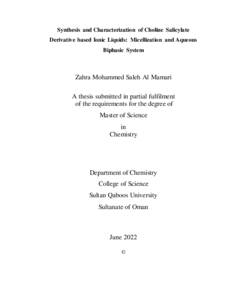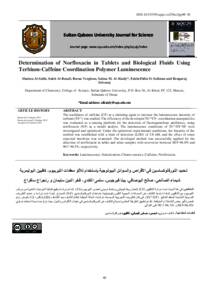Document
Synthesis and characterization of choline salicylate derivative based ionic liquids : micellization and aqueous biphasic system.
Publisher
Sultan Qaboos University.
Gregorian
2022
Language
English
English abstract
Ionic liquids (ILs) indicate a modern class of ionic solvents of bulky cations and
anions, with the feasibility of tuning their thermal and physical properties for various
applications. In the current work new choline salicylate derivatives based ILs such as
Choline Salicylate, [Ch][SA]; Choline para-Methyl Salicylic Acid, [Ch][p-MSA];
Choline para-Amino Salicylic Acid, [Ch][p-ASA]; Choline para-Nitro Salicylic Acid,
[Ch][p-NSA]; Choline para-Chloro Salicylic Acid, [Ch][p-Clsa]; Choline para Hydroxy Salicylic Acid, [Ch][P-HSA]; Di-Choline Salicylic Acid, [Ch]2[SA]; Di Choline p-Methyl Salicylic Acid, [Ch]2[MSA]; Tri-Choline Hydroxy Salicylic Acid,
[Ch]3[HSA] and Choline Acetyl Salicylic Acid, [Ch][AcSA] were synthesized and
characterized using various techniques like NMR, IR, TGA and HPLC-MS. These ILs
are used to study their effect as additives on the properties of aqueous anionic surfactant
sodium dodecyl sulfate (SDS) solutions and the ability of the studied ILs to form
aqueous biphasic systems (ABS) for application in extraction.
Understanding the effect of (ILs) as additives on the properties of aqueous SDS
surfactant solutions is intensely important because of the various applications of
surfactant-based in the industry. Aggregation behavior of SDS were investigated in the
absence and presence of 5 mM ILs in aqueous solutions. The critical micelle
concentration (CMC) values have been estimated for different IL+ surfactant systems
at three different temperatures 288.15, 298.15 and 308.15 K using different techniques
like electrical conductivity and surface tension. The results indicate that the addition of
all employed ILs to SDS surfactant leads to a decrease in the CMC in this order: [Ch][p ClSA]> [Ch][p-NSA] > [Ch][p-ASA] > [Ch][p-HSA] > [Ch][SA] > water. The
obtained CMC values are employed to determine the thermodynamic parameters of
micellization such as standard free energy (∆𝐺𝑚
°
), standard enthalpy (∆𝐻𝑚
°
), and
standard entropy (∆𝑆𝑚
°
). The values of these parameters indicate that adding ILs adjust
the micellization properties of SDS solution. Parameters such as maximum surface
excess concentration (Г𝑚𝑎𝑥), minimum area per molecule (𝐴𝑚𝑖𝑛 ), surface pressure at
CMC (𝜋𝐶𝑀𝐶), the efficiency of adsorption (𝑝𝐶20) and packing parameters (𝑃) were
calculated and analyzed in this study to predict the interfacial behavior of SDS
surfactant for a better understanding of the rule of ILs' anions in upgrading their
efficiencies in comparison with the aqueous system. The values of the standard Gibbs
free energy of micellization (∆𝐺𝑚
) are negative for all systems indicating that the
micellization is a spontaneous process
Recently, choline-based biphasic systems (ABS) have a great interest because
of their "green" separation processes for the extraction of value-added compounds. We
study the effects of the anion of the IL in forming the ABS with tri-potassium phosphate
salt (K3PO4). Seven ILs were able to form ABS. The used ABS system "IL+ salt +
water" was determined at 298.15 K & atmospheric pressure and the respective
solubility curves, tie-lines, and tie-line lengths are reported. The trend in capability of
forming ABS was observed in the following order: [Ch]3[p-HSA] > [Ch]2[p-MSA]
> [Ch]2[SA] >[Ch][AcetylSA] > [Ch][p-ASA] > [Ch][p-MSA] > [Ch][SA]. The
solubility curve was fitted to the Merchuk equation and tie lines were calculated from
mass phase fractions based on the lever arm rule that are described using the Othmer Tobias and Bancroft equations. Also, the ABS is evaluated through its extraction
capability for caffeine using partition coefficient which found to be greater than one in
all studied systems indicating an efficient extraction.
Member of
Resource URL
Arabic abstract
تعتبر السوئل الأيونية من أحدث المذيبات الحديثة ذات خصائص فيزيائية وكيميائية فريدة من نوعها ومناسبة للاستخدام في العديد من التطبيقات مثل فصل المذيب وتنقيتها. في هذه الدراسة تم تصنيع عشر مركبات من السوائل الأيونية باستخدام مادة الكولين و مشتقات حمض الساليسيليك. تستخدم السوائل الأيونية ) ILs )لدراسة تأثيرها كإضافات على خصائص محاليل العامل السطحي الأيوني السالب صوديوم دوديسيل سلفات )SDS )وقدرة السوائل الأيونية المدروسة على تكوين أنظمة مائية ثنائية الطور )ABS )للتطبيق في استخراج مواد عضوية. في هذه الدراسة تم فحص السلوك التجميعي )التكتل( لمادة العامل السطحي الأيوني السالب صوديوم دوديسيل سلفات (SDS (عند غياب و وجود )5 ملي موالر( من السوائل الأيونية )ILs )؛ في وسط مائي عند درجات حرارة مختلفة )288.15 ، 298.15 308.15،( كلفن. تم تقييم قيم تركيز المذيلة الحرج )CMC )ألنظمة IL/ المتذيل السطحي المختلفة من خلال استخدام ثالث تقنيات مختلفة كالموصلية الكهربائية، والتوتر السطحي. كما تمت دراسة تأثير درجة الحرارة على CMC. وتشير النتائج إلى أن إضافة جميع السوائل الأيونية المستخدمة تؤدي إلى انخفاض كبير في قيم CMC ل خافض للتوتر السطحي صوديوم دوديسيل سلفات واتبع هذا الترتيب [Ch][p-ClSA]> [Ch][p-NSA] > [Ch][p-ASA] > [Ch][p-HSA] > [Ch][SA] > water تم استخدام قيم CMC التي تم الحصول عليها لتحديد معلمات أو عوامل الديناميكا الحرارية للتشكيل الدقيق مثل ° (، المحتوى الحراري القياسي ) 𝐻∆ ° طاقة جيبس القياسية الحرة ) 𝐺∆ (، والأنتروبيا المعيارية للتشكيل الدقيق ∆𝑆𝑚( ° ( والتي تم فحصها من حيث القوة الدافعة وراء عملية التجمع أو التكتل. كما تم حساب وتحليل معلمات مثل الحد الأقصى للتركيز السطحي الزائد ) 𝑎𝑚Г)، والمساحة الدنيا لكل جزيء ) 𝑖𝑚𝐴 (، وضغط السطح عند CMC ( ومعلمات التعبئة ) ( في هذه الدراسة لتوقع السلوك البيني للمواد الخافضة 20 (، وكفاءة الأمتزاز ) 𝑝 𝑀𝐶 ) للتوتر السطحي الثالثة في أنظمة IL/المتذيل السطحي من أجل فهم دور الأنيونات في رفع كفاءتها بالمقارنة مع ° النظام المائي. وقد تم رصد قيم سالبة لطاقة جيبس القياسية الحرة ) 𝐺∆ ( لجميع الأنظمة مما يشير إلى أن التجميع عملية تلقائية. حضيت الأنظمة المائية ثنائية الطور القائمة على مادة الكولين باهتمام عال في السنوات الأخيرة بسبب قدرتها العالية الستخراج المركبات ذات القيمة المضافة بطريقة تعتبر خضراء كيميائيا. لقد درسنا تأثير ايون السوائل الأيونية في تكوين الأنظمة المائية ثنائية الطور باستخدام ملح فوسفات ثالثي البوتاسيوم. تمكنت سبع مركبات مصنعة من تكوين أنظمة مائية ثنائية الطور باستخدام النظام التالي " سائل أيوني + ملح + ماء" عند درجة حرارة الغرفة والضغط الجوي. لقد تم دراسة خصائص المنحنيات الذوبانية وخطوط الربط وأطوال خطوط الربط من خلال معادلة ميرتشوك. وقد تم تقييم السوائل الأيونية من خلال قدرتها على استخراج الكافيين.
Category
Theses and Dissertations


